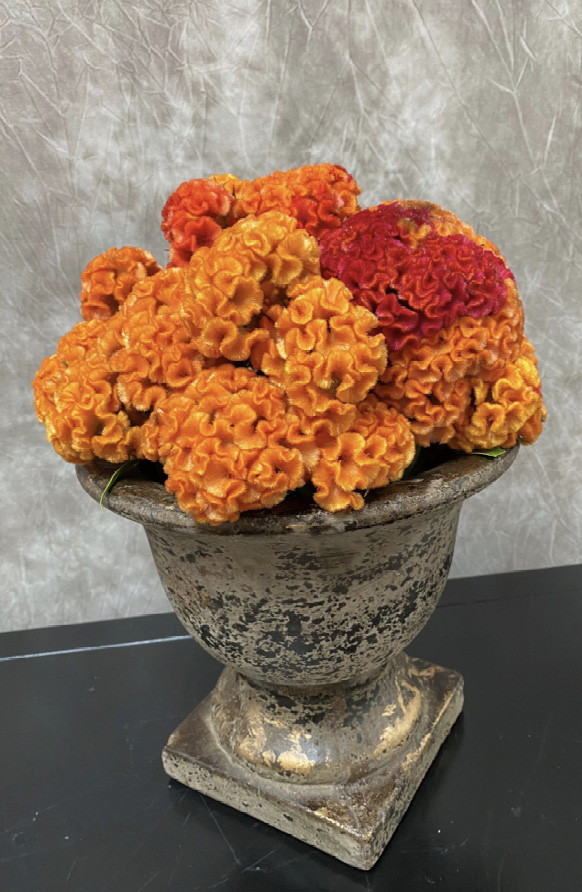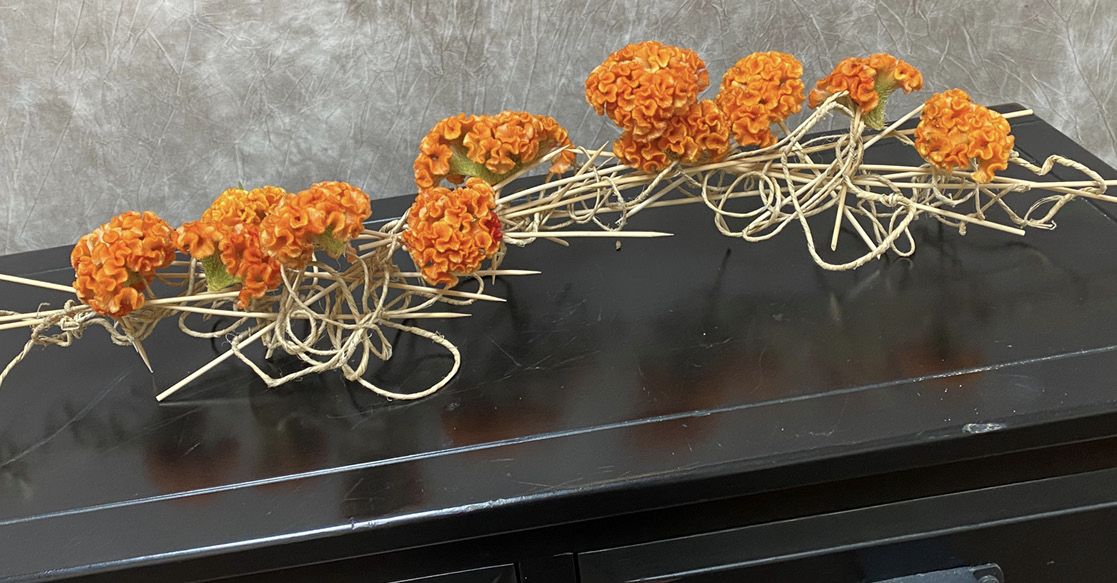Cockscomb (Celosia argentea var. cristata) for the Farmer Florist
A member of the Amaranthaceae family, the name celosia comes from the Greek keleous or “burning,” alluding to the flower’s brilliance. All ornamental forms of celosia are Celosia argentea var. cristata, which encompasses four groups, one of which is the Cristata Group or crested type. Before breeding resulted in larger blooms, the crested celosia, with its small, wavy, fanlike flowers, looked very much like roosters' red combs– hence the popular common name of cockscomb.
In the Victorian language of flowers, celosias signified humor, warmth, and silliness. If you watch people (especially children) walk by celosia plants, you may see a grin. Their quirky flowers do beg for attention. Touch the flowers; they are amazingly soft. The cockscomb or cristata types feel like velvet on the sides of the spike.
Production
Sow seed lightly in 50- to 288-cell plug trays 6 to 8 weeks before last frost date. Place at 72-80 degrees under mist. Light is required for germination, although the intensity can be very low, so supplemental lighting is not necessary. Seed should germinate in 8 to 14 days.
Transplanting plugs into the field on a successive schedule is recommended. Plant transplants in the field as soon as threat of frost has passed, then plant successive crops every 3 to 4 weeks. Plants may be transplanted to a 6x6-inch spacing if grown as a single-harvest, single-stem crop. Plants may also be grown on 12-inch centers, 8x1-inch spacing, or even 18-inch spacing if flowers are to be harvested continuously from a single planting.
Celosia will bloom from spring until late summer but it is a quantitative short-day plant. It will flower at any photoperiod, but flowers faster under photoperiods of 14 hours or less.
Pinching is not necessary for celosia but is highly recommended for cockscombs to increase branching and uniform flower size. When the plant is 8-12 inches tall, pinch the stem with your thumb and index finger or use sterilized scissors to remove the growing point.
Pests and Diseases
Aphids and thrips are the most common pests of celosia. High humidity and extended leaf wetness may maximize occurrence of disease. Improve air flow, use drip irrigation, and provide ample spacing to minimize disease conditions. Flowers in the Amaranth family are susceptible to powdery mildew, which can be identified by a white fungal growth with a powdery appearance on the leaves and occasionally flowers. Preventative fungicide applications may be recommended if conditions are right for fungal growth. The conditions that promote powdery mildew are also conducive to Alternaria leaf blight: warmth, dampness, and high humidity. Copper-containing fungicides are recommended.
Harvest and Postharvest
Celosia is an exceptional fresh or dried cut flower. For fresh use, harvest stems when the flowers are fully developed. Vase life for fresh cut stems ranges from 5 days to 2 weeks and their ideal storage temperature is 36 to 41 degrees. For use as dried flowers, harvest at the same stage of growth and remove foliage from the stem. Hang in a dark, well-ventilated location to dry.
Cultivar Recommendations
Orange Queen Improved provides sturdy, uniform plants with strong stems. Two, 7-inch, densely folded orange combs make useful fresh or dried cut flowers. Plants mature 90 to 120 days from seed. Stems range in height from 36- to 40-inches. The flowers of this plant are featured in this publication.
Celosia Prestige Scarlet is a 1997 All-America Selection Flower Winner. Deep scarlet combs cover entire plants over a prolonged period. Considered a vigorous grower, it is easy to cultivate. Heat tolerant, carefree plants reach 15- to 20-inches in full sun. Combs average 3.5-inches in width.
Cramer’s Series
Cramer's Burgundy, Cramer’s Wine, and Cramer’s Lemon Lime are fertile, crested-type celosias. Flowers bloom prolifically on well-branched plants. With approximately 15 to 20 stems per plant, Cramer's varieties prove to be workhorses in the garden. Their stems reach heights of 30- to 36-inches and their bloom size is approximately 2- to 6-inches across.
Neo Series
Neo Pink Celosia, Neo Gold Celosia, Neo Orange Celosia, Neo Red Celosia, and Neo Rose Celosia bloom from spring to late summer. These stems exhibit stems ranging from 28- to 40-inches long.
Chief Series
Chief Gold, Chief Persimmon, and Chief Carmine produce sturdy, uniform plants with strong stems. Their blooms range from 2- to 7-inches in width. The Chief series matures in 90 to 120 days. Chief Series is great for fresh or dried stems.
Design Applications
Cockscomb, also known as crested celosia, is a highly unique cut flower and easy to grow plant. Floral designers love to use this flower to create focal impact in designs. It has a wide color range with tones that contrast and match designer fabrics. It’s rounded, “brain-shaped” flower head, velvety texture, and wrinkled pattern within the head make this an ideal cut flower for many design applications.
Flowers to Wear and Carry

Boutonniere
One medium sized Celosia cristata flower head is all it takes to make this unique boutonniere, worn over the heart, pinned to the widest part of the jacket lapel. The velvety texture of this flower is a nice contrast to smooth jacket fabrics, including wool and shiny satins. The flower is cross pierced with #28-gauge wire and backed with camellia leaves for textural contrast. The different colors of celosia will provide varying effects to the eye, from soft pinks and pale greens to vibrant reds and brilliant orange.
Handtied Bouquet
Bridesmaids and mother of the bride/groom bouquets can be fun and totally different from the norm. Our freshly harvested design uses approximately seven stems of crested celosia in vivacious orange and red and collared by oak leaves is finished with a trendy ribbon. It is not unusual for a crop of celosia flowers to have a few plants that exhibit different colors. We used this to provide variation to the finished design.
We like to use waterproof tape (also known as florists’ pot tape) to grip the stems in place, then overwrap it with decorative ribbon. Keep your designs simple and use what is already growing on the farm, such as the oak leaves, to increase profit margins.

Table Arrangements
Hemisphere of Celosia in Urn
This design features Celosia cristata arranged in reverse proportion style. In this example, the urn container is greater in size proportion than the plant material mass. We used a glass vase containing chicken wire and fresh flower food solution inside the ceramic urn. We added flowers around the rim of the container first, then additional flowers building to the top of the dome. This classical design works well as a table centerpiece and in numerous other home and event spaces.

Floral Table Runner
Our next concept uses celosia in an uncommon way. For this project, you will need bamboo skewers and sisal covered wire available from craft and floral suppliers. The wire should be approximately #18 gauge so that the supportive design is rigid and stable.



Form the sisal-covered wire into an armature garland of curves and curls. Be sure to create tight curves that will aid in holding the skewers in place.
Prior to adding them into the curved wire, you can blunt sharp ends of the bamboo by trimming them. This lessens the potential for consumer injury. Add bamboo skewers on the horizontal plane into the wire mass. The bamboo skewers aid in making the overall structure rigid. If any of the skewers easily fall out of the wire mass, tighten the wire curves and curls to better hold them in place, then re-insert them.

Once the skewers are in place, pull a few loops open from the flattened wire frame so that the armature is no longer flush against the table. This process helps add an airy dimension to the overall centerpiece. Next, we added additional half-length skewers cut at a sharp angle to accommodate the Celosia cristata flower heads. The shorter skewers were diagonally oriented within the wire to help anchor them in place.

Note in the completed version that the wire loops lift the design off the tabletop making this design concept ideal for seated dinner tables. The same design can also be used on occasion tables and fireplace mantels at event sites. The framework can be tinted a different color and other types of flowers can be added to the design, perhaps including decorative water tubes to sustain wilt-sensitive flowers. Celosia flowers should be processed in fresh flower food solution prior to design. Once in place, coat the design with anti-transpirant spray so that it will remain fresh for the day. You can accent the design with taper candles in modern holders for nighttime events.

Resources
Armitage, A.M. and J.M. Laushman. 2003. Specialty cut flowers: The production of annuals, perennials, bulbs, and woody plants for fresh and dried cut flowers, 2nd ed. Timber Press, Portland, OR. 586pp.
Byczynski, L. 1997. The flower farmer. Chelsea Green, White River Junction, VT.
Hunter, N. 2013. The art of floral design. 3rd ed. Delmar, Clifton Park, NY.
Johnny’s Selected Seeds. 2016. Celosia production (opens PDF).
Johnson, J., McKinley, W., and Benz, B. 2001. Flowers: Creative design. San Jacinto, College Station, TX.
McKinley, W., Cravens, L., DelPrince, J., Scace, P., Gallagher, J., Jaras, J., and McGukin, S. (Eds.). 2022. The AIFD guide to floral design (3rd. Ed.). Schiffer, Atglen, PA.
Scace, P. & DelPrince, J. (2021). Principles of floral design. Goodheart-Willcox.
Vaughn, M.J. 1988. The complete book of cut flower care. Timber Press, Portland, OR. 145pp.
The authors want to acknowledge Scott Langois and the staff of the South Mississippi Branch Experiment Station, Poplarville, for their assistance.
The information given here is for educational purposes only. References to commercial products, trade names, or suppliers are made with the understanding that no endorsement is implied and that no discrimination against other products or suppliers is intended.
Publication 3911 (POD-06-23)
By Christine Coker, Research Professor, Coastal Research and Extension Center; James M. DelPrince, Associate Extension Professor, Coastal Research and Extension Center; Patricia Knight, Director of Coastal Horticulture Research, South Mississippi Branch Experiment Station; and Anthony Bowden, Research Associate, South Mississippi Branch Experiment Station.
The Mississippi State University Extension Service is working to ensure all web content is accessible to all users. If you need assistance accessing any of our content, please email the webteam or call 662-325-2262.




